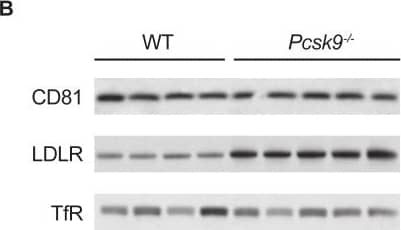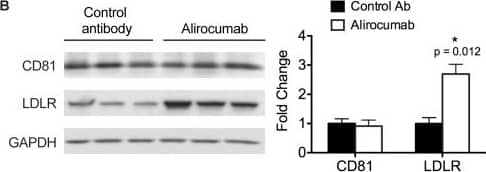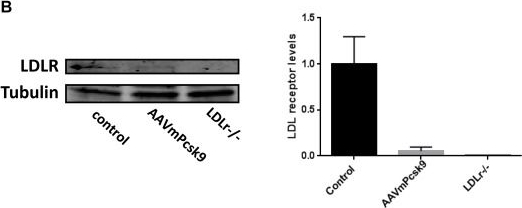Mouse LDLR Antibody
R&D Systems, part of Bio-Techne | Catalog # AF2255


Key Product Details
Validated by
Species Reactivity
Validated:
Cited:
Applications
Validated:
Cited:
Label
Antibody Source
Product Specifications
Immunogen
Ala22-Arg790 (Ala23Val, Cys27Gly)
Accession # Q6GTJ9
Specificity
Clonality
Host
Isotype
Endotoxin Level
Scientific Data Images for Mouse LDLR Antibody
Detection of Mouse LDLR by Western Blot.
Western blot shows lysates of mouse liver tissue. PVDF membrane was probed with 0.1 µg/mL of Goat Anti-Mouse LDLR Antigen Affinity-purified Polyclonal Antibody (Catalog # AF2255) followed by HRP-conjugated Anti-Goat IgG Secondary Antibody (Catalog # HAF017). A specific band was detected for LDLR at approximately 145 kDa (as indicated). This experiment was conducted under reducing conditions and using Immunoblot Buffer Group 1.LDL R in Mouse Liver.
LDL R was detected in perfusion fixed frozen sections of mouse liver using Mouse LDL R Antigen Affinity-purified Polyclonal Antibody (Catalog # AF2255) at 15 µg/mL overnight at 4 °C. Tissue was stained using the Anti-Goat HRP-DAB Cell & Tissue Staining Kit (brown; Catalog # CTS008) and counterstained with hematoxylin (blue). Specific labeling was localized to the bile canaliculi. View our protocol for Chromogenic IHC Staining of Frozen Tissue Sections.Detection of Mouse LDLR by Western Blot
Effect of Pcsk9 deletion on LDLR and CD81 levels in age- and sex-matched Pcsk9-/- mice (n = 5) and their wild type littermates (n = 4).Shown are (A) mean ± SE serum LDL-C levels and (B) Western blot analysis of CD81 and LDLR levels in liver extracts with TfR as loading control, in animals sacrificed after a 4-hour fast. Lanes in panel B represent samples from individual mice. LDL-C, low-density lipoprotein cholesterol; LDLR, low-density lipoprotein receptor; PCSK9, proprotein convertase subtilisin/kexin type 9; SE, standard error; TfR, transferrin receptor; wt, wild type. Image collected and cropped by CiteAb from the following publication (https://dx.plos.org/10.1371/journal.pone.0154498), licensed under a CC-BY license. Not internally tested by R&D Systems.Applications for Mouse LDLR Antibody
Blockade of Receptor-ligand Interaction
CyTOF-ready
Flow Cytometry
Sample: Serum-deprived RAW 264.7 mouse monocyte/macrophage cell line
Immunohistochemistry
Sample: Perfusion fixed frozen sections of mouse liver
Western Blot
Sample: Mouse Liver Tissue
Reviewed Applications
Read 1 review rated 5 using AF2255 in the following applications:
Formulation, Preparation, and Storage
Purification
Reconstitution
Formulation
Shipping
Stability & Storage
- 12 months from date of receipt, -20 to -70 °C as supplied.
- 1 month, 2 to 8 °C under sterile conditions after reconstitution.
- 6 months, -20 to -70 °C under sterile conditions after reconstitution.
Background: LDLR
The low density lipoprotein receptor (LDL R) is the founding member of the LDL R family of scavenger receptors (1, 2, 3, 4). This family contains type I transmembrane molecules that are characterized by the presence of EGF repeats, complement-like repeats, and YWTD motifs that form beta-propellers. Although members of the family were originally thought to be endocytic receptors, it is now clear that some members interact with adjacent cell-surface molecules, expanding their range of activities (2, 4). Mouse LDL R is synthesized as a 864 amino acid (aa) precursor that contains a 21 aa signal sequence, a 769 aa extracellular region, a 22 aa transmembrane segment and a 52 aa cytoplasmic tail (5). The extracellular region is complex. It consists of seven N-terminal complement-like cysteine-rich repeats (class A LDL domains) that bind LDL. Cysteines in this region participate in intrachain disulfide bonds. This region is followed by two EGF-like domains and six class B LDL repeats that generate a beta-propeller whose blades each contain a YWTD motif. This area is likely responsible for ligand dissociation (6). Finally, there is a 50 aa membrane proximal Ser/Thr-rich region that shows extensive O-linked glycosylation, generating a native molecular weight for LDL R of 135 kDa (5). Within the 52 aa cytoplasmic region, there is an NPxY motif that links the receptor to clathrin pits and binds to select adaptor proteins (1, 7, 8). The extracellular region of mouse LDL R shares 78% and 87% aa identity with the extracellular region of human and rat LDL R, respectively. LDL R is constitutively expressed and binds apoB of LDL and apoE of VLDL (9). It is responsible for clearing 70% of plasma LDL in liver (9).
References
- Strickland, D.K. et al. (2002) Trends Endocrinol. Metab. 13:66.
- Nykjaer, A. and T.E. Willnow (2002) Trends Cell Biol. 12:273.
- Gent, J. and I. Braakman (2004) Cell. Mol. Life Sci. 61:2461.
- Bujo, H. and Y. Saito (2006) Arterioscler. Thromb. Vasc. Biol. 26:1246.
- Hoffer, M.J. V. et al. (1993) Biochem. Biophys. Res. Commun. 191:880.
- Rudenko, G. and J. Deisenhofer (2003) Curr. Opin. Struct. Biol. 13:683.
- Trommsdorff, M. et al. (1998) J. Biol. Chem. 273:33556.
- Stolt, P.C. and H.H. Bock (2006) Cell. Signal. 18:1560
- Defesche, J.C. (2004) Semin. Vasc. Med. 4:5.
Long Name
Alternate Names
Entrez Gene IDs
Gene Symbol
UniProt
Additional LDLR Products
Product Documents for Mouse LDLR Antibody
Product Specific Notices for Mouse LDLR Antibody
For research use only





